Plants for Problem Places - North Facing Walls and Deep Shade
Most gardens have at least one spot that does not seem to want to grow plants. Perhaps it is very wet or very dry, it could be a wind funnel, the soil might be particularly poor or there is too much shade, This is the first of a series of articles about growing food plants in those difficult positions - this one will focus on those dark areas of the garden where plants always look somewhat thrifty.
This deep shade can be caused by two main reasons - either the land is heavily shaded by the dense growth of trees and shrubs or it is in the almost permanent shade of a structure such as a wall. These two types of shade are rather different from each other and so we will look at each of them in a little more detail.
The north-facing side of any structure will only receive small amounts of sunshine in the early morning and late afternoon in the summer. In the winter it will not see the sun at all. However there will be quite a lot of indirect light all year round and so this is a lighter area than the deep shade of the woodland. Since it receives so little direct sunlight it will be considerably cooler than the other sides of the structure. It will also tend to be moister since the sun will evaporate less of the water from the soil. Establishing plants in this situation is usually fairly simple since there is little root competition.
The dense shade caused by other plants is of two main types and is a much more difficult habitat to utilize. The shade can be caused by deciduous or evergreen species, thus with deciduous species there will be several months of the year when the shade will much less because the trees are not in leaf. This allows a number of plants that do most of their growing before late spring to succeed. When walking in deciduous woodlands in the spring you might see carpets of wild garlic or bluebells in flower but come the middle of the summer and these plants will have entirely disappeared. The shade of evergreen trees and shrubs, however, remains dense throughout the year and thus greatly restricts the range of plants that will succeed under them. In both of these types of shade the summers are going to be dark and so any plants growing there will need to be able to utilize every little scrap of light that reaches them. There will be lots of competition from the roots of the trees and shrubs, whilst the soil is likely to be quite dry in the summer. Thus it is going to be very difficult to establish plants in this situation. The best way of doing this is to sow the seed direct where you want the plants to grow - this can be quite wasteful of seed but at least the roots of the seedlings will be in proportion to the size of the top growth and the plants that do germinate will usually establish well. To get the most plants from your seed you will usually find that sowing it in trays and potting up the seedlings will bring good results. It is important to plant out these seedlings when they are still small and it can be very helpful to remove tree roots from around the young plants to give them more space to become established. Late winter or early spring is the best time to plant them out. It is important to remember here that I am not talking about the dappled shade of a woodland (see our leaflet Woodland Garden Plants for information on this), but rather the dense shade that lets very little light in, especially during the late spring and summer months when most plant growth takes place.
There are a surprising number of plants that will do very nicely, thank-you, in the densest of shade. Unfortunately, the majority of them do not produce food for us. However, the plants detailed below should hopefully give you a lot of ideas for growing food even in these difficult situations. The plants are sorted according to their growth habit and garden habitat. Unless the text says otherwise, all the plants listed below are hardy throughout most of Britain.
Trees and Shrubs for North-Facing Walls
Although north-facing walls receive so little direct sunlight, there are a number of good fruiting species that will grow and produce well there. The main drawback is that, due to the lack of sun, the fruit will probably not develop such a rich flavour in such a situation. This leaflet will look mainly at the less usual food crops though I would like to remind you of the more common fruits that can be grown there.
One of my first choices would be gooseberries. By growing them on the north-facing wall of a house you will greatly reduce bird damage since the birds will be nervous about spending too much time so near to human activity. In addition, the fruit will ripen a few weeks later than in the open garden, thus extending the fruiting season. Black and red currants will also succeed on a north-facing wall, though to my mind they do not do as well as the gooseberries. Another very good choice is the Morello cherry. The tree will need to be fan-trained in order to keep it within reasonable bounds, but you should find it fruits regularly and well in such a position. Blackberries will also grow well along a north wall, but their fruit will not develop anywhere near as well as in the open garden and the thorns on the stems could make the plant rather antisocial unless you make sure to train it to the wall.
Of the less usual fruits, we would recommend the following:-
 Elaeagnus x ebbingei. This evergreen shrub can grow 4 metres or more tall and wide, though it responds very well to trimming and can easily be kept back to 2 metres or less. A very easily grown plant, it will succeed in almost any soil as long as it is well-drained. In addition, there are nitrogen-fixing bacteria that live on its roots and so it will enrich the soil with nitrogen.
Elaeagnus x ebbingei. This evergreen shrub can grow 4 metres or more tall and wide, though it responds very well to trimming and can easily be kept back to 2 metres or less. A very easily grown plant, it will succeed in almost any soil as long as it is well-drained. In addition, there are nitrogen-fixing bacteria that live on its roots and so it will enrich the soil with nitrogen.
The type-species is a fairly dull looking plant, there are various cultivars available with differing degrees of yellow variegation in the leaves, but unfortunately these do not generally produce fruit in Britain. However, it is not just looks by which we can judge a plant. Come November this species will reward you with the most deliciously scented tiny flowers that will fill the whole garden with their perfume. As long as the correct form of the species is chosen (it can be obtained from our mail order catalogue) then your next reward will come in early April when the fruits ripen. These need to be fully ripe and squidgy soft otherwise they will make your mouth pucker, but when fully ripe they have a lovely rich taste. In addition their large seed can also be eaten and is a good source of protein and fats.
Any of the other evergreen species of Elaeagnus can also be grown for their spring fruit, though they tend to be unreliable croppers. This subject is dealt with in much more detail in our leaflet Elaeagnus x ebbingei - A Plant for all Reasons.
.jpg) Fuchsia species. Although widely grown in gardens, few people realise that fuchsia fruits are edible and, if the right cultivars or species are chosen, they can make a very acceptable dessert in late summer and early autumn. It is always worth your while tasting the fruits of any fuchsia you see - at the worst you will end up with a peppery after-taste in the mouth and, with the better forms, you will have a delicious fruit.
Fuchsia species. Although widely grown in gardens, few people realise that fuchsia fruits are edible and, if the right cultivars or species are chosen, they can make a very acceptable dessert in late summer and early autumn. It is always worth your while tasting the fruits of any fuchsia you see - at the worst you will end up with a peppery after-taste in the mouth and, with the better forms, you will have a delicious fruit.
Fuchsias are easily accommodated plants succeeding in most conditions including heavy clay soils. They are not that hardy, but there are cultivars that will resprout from the roots even if the top growth is killed back in the winter. They vary in height and width according to cultivar but are in general less than 1 metre tall.
Of those cultivars that we recommend for their fruit, Globosa and Tresco are highly recommended. We have also been told that the fruit of Schönbrunner Schuljubiläum is very morish but have not as yet tried it ourselves.
Of the species that we recommend, F. splendens produces an exquisite fruit about the size and shape of a baby's little finger. This species., unfortunately, can only be grown successfully in the milder parts of the country. F. microphylla is a little hardier, the fruit is round and smaller than currants but produced in reasonable quantities. F. coccinea is hardier still, though it still will not succeed in the colder parts of the country. The fruit is about 17mm long and once more shaped somewhat like a finger.
.jpg) Gaultheria procumbens. The Checkerberry is a prostrate evergreen shrub that makes a good ground cover in acid soils. Only 10 - 15cm tall, it spreads by perhaps 10 - 20cm per year and so, if allowed, will eventually take up quite a bit of space. Once established, it succeeds in dry soils and is quite drought-tolerant. A very cold-hardy plant, tolerating temperatures down to about -35°c.
Gaultheria procumbens. The Checkerberry is a prostrate evergreen shrub that makes a good ground cover in acid soils. Only 10 - 15cm tall, it spreads by perhaps 10 - 20cm per year and so, if allowed, will eventually take up quite a bit of space. Once established, it succeeds in dry soils and is quite drought-tolerant. A very cold-hardy plant, tolerating temperatures down to about -35°c.
The fruit is about 15mm in diameter and has a very strong spicy taste that reminds me of germolene. It is just like being in a hospital waiting room! This is a fruit that you will either love or hate - there are few people who are indifferent to it. The fruit tastes best after a frost and it will hang onto the plant until spring if it is not eaten by birds so you can have a nibble on it throughout the winter. We like eating small quantities of the fruit raw, though it can also be used in pies, or made into jams etc. There are some named forms, look out for "Dart's Red Giant" which has specially large berries.
Closely related is G. shallon, the salal. This is a taller and more vigorous species, reaching 1.5 metres tall and gradually spreading if allowed to form clumps 2 metres or more across. It has the same needs as G. procumbens and the fruit, which ripens in late summer, has a pleasant mild flavour.
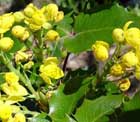 Mahonia aquifolium. The oregon grape is one of the easiest plants to grow, thriving in almost any soil including heavy clays and dry conditions. An evergreen shrub, it grows about 2 metres tall and suckers to form a clump 1.5 metres or more in diameter. The plant flowers in the winter and early spring, its bright yellow flowers bringing a taste of summer to the garden.
Mahonia aquifolium. The oregon grape is one of the easiest plants to grow, thriving in almost any soil including heavy clays and dry conditions. An evergreen shrub, it grows about 2 metres tall and suckers to form a clump 1.5 metres or more in diameter. The plant flowers in the winter and early spring, its bright yellow flowers bringing a taste of summer to the garden.
The fruit ripens in late summer. It is about the size of a blackcurrant and is usually produced in large bunches which makes picking very easy. The flavour is rather on the acid side, which puts some adults off, though children generally love it. I find it very acceptable in small quantities raw and it also goes very well in muesli or porridge (assuming you like purple porridges!) It does have rather a lot of seeds, however, which can be a pain.
There are a number of other Mahonia species that grow well in shady conditions, flowering in the winter and producing their edible fruits in late spring. These include M. japonica, M. bealei and the various cultivars of M. x media including "Bucklandii", "Charity" and "Lionel Fortescue". The fruits are quite juicy and have a pleasant acid flavour when fully ripe. Fruits are sometimes formed without their usual complement of large seeds - whilst this might seem an improvement these fruits are unfortunately quite bitter and unpleasant to eat.
Climbing Plants for North-Facing Walls
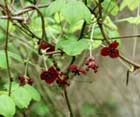 Akebia quinata. The akebia is quite a vigorous semi-evergreen plant that can climb 12 metres or more into trees and shrubs, though it is very amenable to trimming - which is best done in early spring. If it does not find anything to support it then it will scramble over the ground, the branches rooting into the earth and making an acceptable ground cover amongst taller plants. It requires a well-drained moisture retentive soil and will succeed in acid or alkaline conditions. Whilst the dormant plant is hardy to about -20°c, the young growth in spring, even on mature plants, is frost-tender and so it is best to grow the plants in a position sheltered from the early morning sun
Akebia quinata. The akebia is quite a vigorous semi-evergreen plant that can climb 12 metres or more into trees and shrubs, though it is very amenable to trimming - which is best done in early spring. If it does not find anything to support it then it will scramble over the ground, the branches rooting into the earth and making an acceptable ground cover amongst taller plants. It requires a well-drained moisture retentive soil and will succeed in acid or alkaline conditions. Whilst the dormant plant is hardy to about -20°c, the young growth in spring, even on mature plants, is frost-tender and so it is best to grow the plants in a position sheltered from the early morning sun
The fruit can be 5 - 10cm long and has a delicate flavour and a soft, juicy texture. Unfortunately, is seldom produced in Britain, possibly because the plant is self-sterile and only one clone is being grown in this country. Where possible try to obtain two plants from genetically different sources - preferably by growing your own plants from seed since each seedling will be genetically different from any other seedling.
There are two other members of this genus with similar growth habits and uses. These are A. triphylla and A. x pentaphylla.
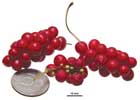 Schisandra chinensis. schisandra is a deciduous climber that supports itself by twining around the branches of other plants and can reach 9 metres in height. It prefers a slightly acid rich well-drained but moisture retentive soil, and will tolerate some alkalinity if plenty of organic matter is added. Whilst the fully dormant plant is hardy to about -17°c, the young growth in spring can be damaged by late frosts. Plants are usually either male or female and at least one male is required for every 5 females if fruit is to be produced.
Schisandra chinensis. schisandra is a deciduous climber that supports itself by twining around the branches of other plants and can reach 9 metres in height. It prefers a slightly acid rich well-drained but moisture retentive soil, and will tolerate some alkalinity if plenty of organic matter is added. Whilst the fully dormant plant is hardy to about -17°c, the young growth in spring can be damaged by late frosts. Plants are usually either male or female and at least one male is required for every 5 females if fruit is to be produced.
The individual red fruits are only about 6mm in diameter but are produced in small grape-like bunches about 10cm long. They can be eaten raw or cooked. The fruit has a sweet yet also sour flavour, in fact the Chinese say it contains the whole range of flavours that we are able to detect! In Russia and China it is usually dried and used on journeys because it is very sustaining.
This plant is also very interesting in that the dried fruit is used as a ginseng substitute in China where it is claimed to have a generally positive affect on the overall health of the body.
S. grandiflora produces perhaps a nicer tasting fruit and the spring flowers are absolutely beautiful.
Herbaceous Plants for North-Facing Walls
There are many plants that will grow nicely in this position. Some of them will grow well in the soil at the base of the wall, whilst there are also several that can actually be grown in the wall if it is of suitable construction. The best walls for plants to grow in are dry-stone walls which have little pockets of soil in them for the plants to root into. However, even brick walls will allow some plants to grow in them so long as the mortar has become somewhat crumbly with age.
The plants listed below are all suitable for north-facing walls but, unless the text says otherwise, they will not succeed in the dense shade of other plants. However, all the plants mentioned later as being suitable for the dense shade of other plants should also succeed by a north-facing wall.
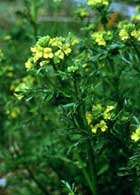 Barbarea verna. land cress is a biennial plant, but it usually self-sows freely and so once you have it you are unlikely to be without it. It grows best in a moist well-drained soil and usually attains a height of around 30cm.
Barbarea verna. land cress is a biennial plant, but it usually self-sows freely and so once you have it you are unlikely to be without it. It grows best in a moist well-drained soil and usually attains a height of around 30cm.
The leaves have a hot, spicy watercress flavour and are delicious as a flavouring in salads. When grown by a north-facing wall they will provide an abundance of leaves from early spring until the autumn and a small picking in the winter. If you want more winter leaves then grow some plants in a sunnier position - see our Winter Salads leaflet for more information on growing leaves for winter use.
Cryptotaenia japonica. MITSUBA, or JAPANESE PARSLEY, is a short-lived perennial growing to 1 metre tall when in flower and about 60cm wide. It succeeds in most soils, preferring a moist shady position under trees where it often self-sows. The leaves tend to turn yellow when plants are grown in full sun. It is not winter-hardy in all areas of Britain, though plants can tolerate short periods at temperatures down to about -10°c.
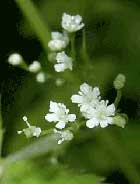 Mitsuba is commonly cultivated as a vegetable in Japan and there are some named varieties. It does not always survive the winter and so it is usually grown as an annual. The main problem with growing it is that the plant is adored by slugs and snails and must be protected when small or when new growth is emerging in the spring.
Mitsuba is commonly cultivated as a vegetable in Japan and there are some named varieties. It does not always survive the winter and so it is usually grown as an annual. The main problem with growing it is that the plant is adored by slugs and snails and must be protected when small or when new growth is emerging in the spring.
The leaves and stems can be eaten raw or cooked, they have a parsley-like flavour if you let your imagination run away with you. The seedlings and young leaves can be used in salads whilst older leaves are used as a flavouring. When cooking, the leaves should not be cooked for more than a couple of minutes or the flavour is destroyed.
.jpg) Campanula portenschlagiana and C. poscharskyana. These two somewhat similar species of CAMPANULA grow about 15cm tall and spread freely to form quite extensive evergreen clumps. They prefer a moist but well-drained rich sandy loam and a neutral or alkaline soil in full sun though they will also do very well on a north-facing walls. The plants are very drought-tolerant and can be grown on a dry stone wall, if planted at the base of an old brick wall they will gradually spread up it.
Campanula portenschlagiana and C. poscharskyana. These two somewhat similar species of CAMPANULA grow about 15cm tall and spread freely to form quite extensive evergreen clumps. They prefer a moist but well-drained rich sandy loam and a neutral or alkaline soil in full sun though they will also do very well on a north-facing walls. The plants are very drought-tolerant and can be grown on a dry stone wall, if planted at the base of an old brick wall they will gradually spread up it.
The leaves are not of the best quality, they are a bit on the tough side but have a pleasant sweet flavour. Since the plants are evergreen, they can be picked all year round so we tend to only use them in the winter when there is less variety available.
The flowers have a pleasant sweet flavour and make a decorative addition to the salad bowl.
.jpg) Reichardia picroides. FRENCH SCORZONERA is a small dandelion-like plant to about 30cm tall when in flower. It is easily grown in any moderately fertile well-drained soil and generally prefers a sunny position. However, it grows best in a shady position in the summer and will produce better quality leaves in such a position. It prefers plenty of moisture in the growing season though it is fairly drought tolerant once established. Plants are also very tolerant of poor soils. It is not very hardy in the colder areas of the country, tolerating temperatures down to between -5 and -10°c, though it is likely to be hardier when grown in a soil on the poor soil. One main benefit of this plant is that it has proved to be almost totally slug-proof, even in a very heavily slug-infested garden.
Reichardia picroides. FRENCH SCORZONERA is a small dandelion-like plant to about 30cm tall when in flower. It is easily grown in any moderately fertile well-drained soil and generally prefers a sunny position. However, it grows best in a shady position in the summer and will produce better quality leaves in such a position. It prefers plenty of moisture in the growing season though it is fairly drought tolerant once established. Plants are also very tolerant of poor soils. It is not very hardy in the colder areas of the country, tolerating temperatures down to between -5 and -10°c, though it is likely to be hardier when grown in a soil on the poor soil. One main benefit of this plant is that it has proved to be almost totally slug-proof, even in a very heavily slug-infested garden.
The leaves make an excellent salad, they have a pleasant agreeable flavour with a slight sweetness and very little fibre - we find them greatly superior to lettuces and use them in large quantities in salads. If the winters are mild then it is possible to harvest the leaves all year round, though plants for winter use need to be in a warm sunny sheltered position.
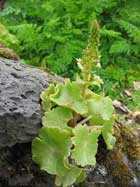 Umbilicus rupestris. PENNYWORT is a native evergreen plant growing about 30cm tall. An easily grown plant, it is found on acid soils in the wild but will succeed in any near neutral, gritty, moisture retentive but well-drained soil in sun or shade. Plants are often found growing on walls in the wild, even succeeding on old brick and mortar walls.
Umbilicus rupestris. PENNYWORT is a native evergreen plant growing about 30cm tall. An easily grown plant, it is found on acid soils in the wild but will succeed in any near neutral, gritty, moisture retentive but well-drained soil in sun or shade. Plants are often found growing on walls in the wild, even succeeding on old brick and mortar walls.
The leaves can be eaten raw or cooked and have a very acceptable mild flavour in the winter and early spring, they can be used in quantity in salads at this time. The leaves become rather stronger-tasting in the summer and are not so pleasant then.
Viola odorata. SWEET VIOLET is another evergreen native plant. It grows about 15cm tall and spreads quite  vigorously to form large clumps. It makes an excellent ground cover. The plant succeeds in most soils but prefers a cool moist well-drained humus-rich soil in partial or dappled shade and protection from scorching winds.
vigorously to form large clumps. It makes an excellent ground cover. The plant succeeds in most soils but prefers a cool moist well-drained humus-rich soil in partial or dappled shade and protection from scorching winds.
The leaves have a fairly bland flavour with a slightly tough texture. Not the most wonderful of leaves but quite acceptable as part of a mixed salad. Perhaps the nicest part of the plant to eat is the flowers. These are produced in late winter and early spring, they have a delicious sweet scent and make a wonderful addition to mixed salads.
Plants for Dense Shade
There are a surprising number of plants that will do very well in deep woodland shade, the following selection include come of the most tasty.
 Allium ursinum. RAMSONS, or WILD GARLIC, is a native species that can grow prolifically in woodlands, often forming large colonies. It prefers a moist well-drained soil and is often found in the wild growing in quite wet situations. Plants come into growth in January or February, they flower in the spring and have completely disappeared by mid summer thus allowing other plants to grow in the same space during the summer.
Allium ursinum. RAMSONS, or WILD GARLIC, is a native species that can grow prolifically in woodlands, often forming large colonies. It prefers a moist well-drained soil and is often found in the wild growing in quite wet situations. Plants come into growth in January or February, they flower in the spring and have completely disappeared by mid summer thus allowing other plants to grow in the same space during the summer.
The leaves, coming as they do in late winter, are a very welcome addition to our salads and cooked foods. They have a moderately strong garlic flavour, though this reduces as the leaves get older. The flowers have a slightly stronger flavour and make a very attractive addition to salads whilst the small bulbs can be used just like garlic.
Two other species, A. paradoxum and A. triquetrum, are naturalized in Britain though they are not hardy in the colder areas. They both produce their leaves from the autumn until the spring. These have a milder, somewhat leek-like flavour. The flowers and bulbs of both these species are also edible. One word of warning about A. paradoxum - there is one form of this species that produces bulbils instead of flowers. This form can be quite invasive and will not respect the boundaries of your own land so it is best avoided.
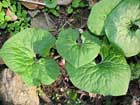 Asarum canadense. SNAKE ROOT grows about 10cm tall but spreads slowly to form clumps 50cm or more across. It prefers a rich moist neutral to acid soil though it is also found on alkaline soils in the wild. It makes quite a useful ground cover.
Asarum canadense. SNAKE ROOT grows about 10cm tall but spreads slowly to form clumps 50cm or more across. It prefers a rich moist neutral to acid soil though it is also found on alkaline soils in the wild. It makes quite a useful ground cover.
The underground stem and the flowers are used as a ginger substitute. The root, especially when quite dry, has a pungent, aromatic smell like mild pepper and ginger mixed, but more strongly aromatic, it is best harvested in autumn but is available all year round and can be dried for later use.
.jpg) Montia perfoliata. miner's lettuce is an annual plant, but it usually self-sows very freely. It grows about 15cm tall, preferring a moist peaty soil. An easily grown plant, it can also succeed on very poor and dry soils.
Montia perfoliata. miner's lettuce is an annual plant, but it usually self-sows very freely. It grows about 15cm tall, preferring a moist peaty soil. An easily grown plant, it can also succeed on very poor and dry soils.
The edible leaves have a fairly bland flavour with a mucilaginous texture, they are quite nice in a salad though we do not like them cooked.
M. sibirica, pink purslane, is a related species that makes an excellent ground cover. It is one of the few plants that will succeed in the dense shade of a beech wood. The leaves have a strong earthy flavour of raw beetroot which some people like, but is not for me.
Both of these species are incredibly hardy and produce their leaves all year round in all parts of the country.
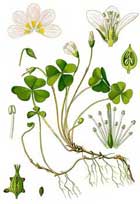 Oxalis acetosella. Our native wood sorrel grows about 10cm tall and forms a gradually spreading clump 30cm or more across. It prefers moist shady conditions and a humus rich soil, it dislikes very heavy and wet soils.
Oxalis acetosella. Our native wood sorrel grows about 10cm tall and forms a gradually spreading clump 30cm or more across. It prefers moist shady conditions and a humus rich soil, it dislikes very heavy and wet soils.
Both the leaves and the flowers have an acid lemon-like flavour. Children especially are very fond of them though most adults also like them. They should not be eaten in quantity, however, because they contain oxalic acid which can prevent us absorbing calcium from our food. Anyone with arthritis r related diseases should also avoid them since they can aggravate the symptoms.
Smilacena racemosa and S. stellata. False spikenard grows up to 1 metre tall and forms a clump about 60cm across. 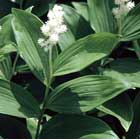 An easy plant to grow, it requires a deep fertile humus rich moisture retentive soil, neutral to slightly acid, that does not dry out in the growing season. Plants do take a few years to become established and are very susceptible to slugs and snails, especially in their establishing years.
An easy plant to grow, it requires a deep fertile humus rich moisture retentive soil, neutral to slightly acid, that does not dry out in the growing season. Plants do take a few years to become established and are very susceptible to slugs and snails, especially in their establishing years.
The fruit has a delicious bitter-sweet flavour, suggesting bitter molasses. It ripens in late summer and hangs well on the plants - we have picked very delicious fruits in late October. Some caution is advised since the raw fruit is said to be laxative in large quantities, though this is only if you are not used to eating it. Thorough cooking removes much of this laxative element.
Database
The database has more details on these plants: Akebia quinata, Allium ursinum, Asarum canadense, Barbarea verna, Campanula portenschlagiana, Cryptotaenia japonica, Elaeagnus x ebbingei, Gaultheria procumbens, Mahonia aquifolium, Oxalis acetosella, Reichardia picroides, Schisandra chinensis, Smilacena racemosa, Umbilicus rupestris, Viola odorata.